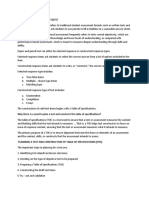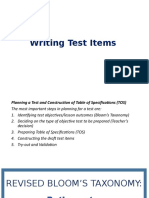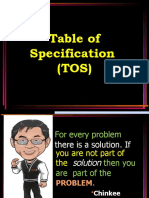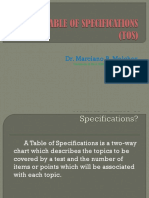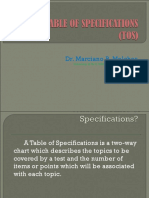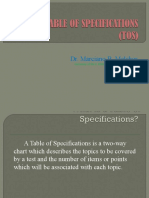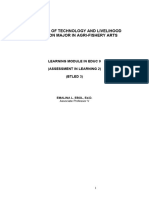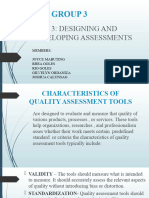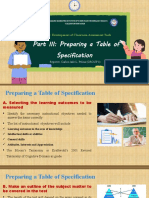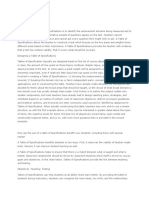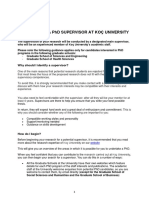A table of specification (TOS) can be used to help teachers frame the decision-making process of test
construction and improve the validity of teachers’ evaluations based on tests constructed for classroom use.
What is a Table of Specifications?
A TOS, sometimes called a test blueprint, is a table that helps teachers align objectives, instruction, and
assessment (e.g., Notar, Zuelke, Wilson, & Yunker, 2004). This strategy can be used for a variety of assessment
methods but is most commonly associated with constructing traditional summative tests. When constructing a
test, teachers need to be concerned that the test measures an adequate sampling of the class content at the
cognitive level that the material was taught. The TOS can help teachers map the amount of class time spent on
each objective with the cognitive level at which each objective was taught thereby helping teachers to identify
the types of items they need to include on their tests. There are many approaches to developing and using a
TOS advocated by measurement experts (e.g., Anderson, Krathwohl, Airasian, Cruikshank, Mayer, Pintrich,
Raths, & Wittrock, 2001, Gronlund, 2006; Reynolds, Livingston, & Wilson, 2006).
What is the Purpose of a Table of Specifications?
In order to understand how to best modify a TOS to meet your needs, it is important to understand the goal of
this strategy: improving validity of a teacher’s evaluations based on a given assessment. Validity is the degree
to which the evaluations or judgments we make as teachers about our students can be trusted based on the
quality of evidence we gathered (Wolming & Wilkstrom, 2010)
A table of specification is a tool that helps teachers plan and design a test that covers the topics and objectives
of the course. It also ensures that the test has content validity, meaning that it measures what it is supposed
to measure.
A table of specification has two dimensions: the content or domain to be tested, and the cognitive level or skill
to be assessed. The content dimension lists the topics or subtopics of the course, while the cognitive
dimension lists the levels of Bloom's taxonomy, such as knowledge, comprehension, application, analysis,
synthesis, and evaluation. A table of specification shows how many items or points will be allocated to each
topic and each cognitive level, based on their importance and difficulty. The table can also indicate the type of
items to be used, such as multiple choice, true or false, matching, short answer, or essay. To construct a table
of specification for a true or false test, the teacher needs to follow these steps:
1. Identify the test objectives and the domain to be covered. The teacher can use the course syllabus, the
textbook chapters, the lesson plans, and the classroom objectives as sources of information
. 2. Divide the domain into key or fairly independent parts, such as concepts, terms, procedures, or
applications. These will form the rows of the table.
3. Decide on the cognitive levels to be measured, such as knowledge, comprehension, application, or analysis.
These will form the columns of the table. Since true or false items are usually limited to lower levels of
cognition, the teacher may not need to include synthesis or evaluation levels.
4. Assign the number of items or points to each cell of the table, based on the weight and difficulty of each
topic and each cognitive level. The teacher can use percentages, fractions, or whole numbers to indicate the
distribution of items or points. The total number of items or points should match the desired length and
duration of the test.
5. Construct the test items according to the specifications of the table. The teacher should ensure that the
items are clear, accurate, relevant, and fair. The teacher should also avoid using ambiguous, trivial, or negative
statements in the true or false items.








